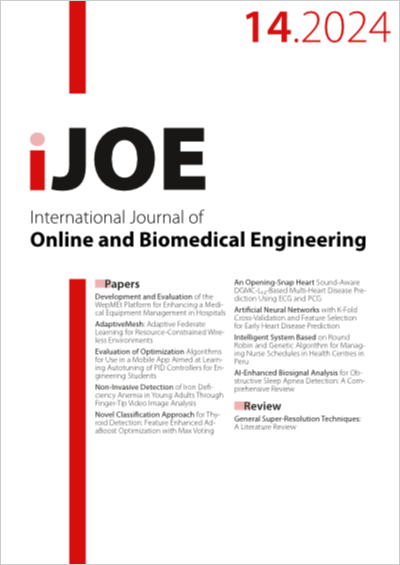Non-Invasive Detection of Iron Deficiency Anemia in Young Adults Through Finger-Tip Video Image Analysis
DOI:
https://doi.org/10.3991/ijoe.v20i14.50141Keywords:
artificial intelligence, convolutional neural network (CNN), iron deficiency anemia detection, non-invasive technique, supervised learningAbstract
In this study, we propose the use of a convolutional neural network (CNN) (2+1) D-based model for the non-invasive detection of iron deficiency anemia using smartphones, addressing the need for accessible and efficient diagnostic methods. We have collected fingertip images from 909 young people, creating a robust dataset to train and validate the model through machine learning (ML), providing us with both spatial and temporal information. Our approach stands out for its simplicity and potential to be implemented in diverse contexts, which facilitates early and accurate diagnosis of anemia. The results show remarkable performance indices in the validation set: an accuracy of 0.9840, a precision of 0.9830, a sensitivity (recall) of 0.9840, an F1-Score of 0.9835, and an AUC ROC of 0.9878, demonstrating the model’s high ability to effectively classify anemic states. These findings validate the efficacy of the model to significantly improve the detection of iron deficiency anemia, promoting the use of mobile technologies and machine learning for more accessible and efficient diagnosis globally. This breakthrough marks a significant step towards improving access and efficiency in health diagnostics through smartphone technology and machine learning, opening new avenues for the effective management of anemia and other health conditions.
Downloads
Published
How to Cite
Issue
Section
License
Copyright (c) 2024 Miguel Angel Valles-Coral, Jorge Raul Navarro-Cabrera, Lloy Pinedo, Richard Injante, Luz Karen Quintanilla-Morales, María Elena Farro-Roque

This work is licensed under a Creative Commons Attribution 4.0 International License.



